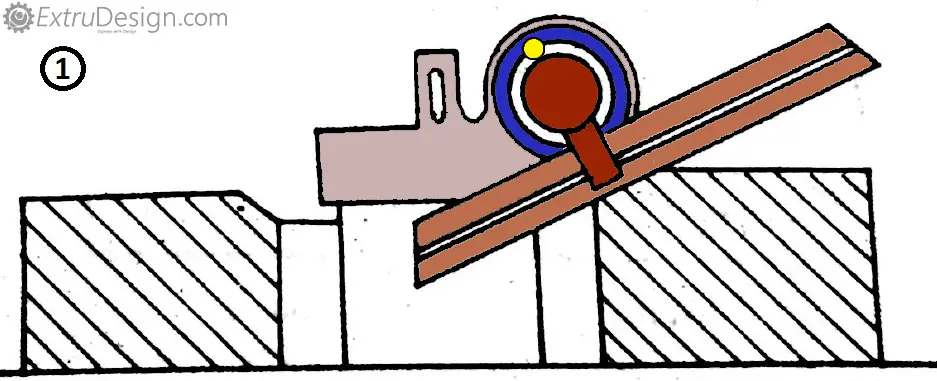Optical Bevel Protractor is the development of the Vernier Bevel Protractor which has the ability to measure the angles up to 2 minutes. But in vernier Bevel protractor it is 5 minutes. In this article, we are going to discuss the Construction and the working principle of the Optical Bevel Protractor.

Optical Bevel Protractor

Optical bevel Protractor is the advancement of the Vernier Bevel Protractor with the additional optical magnifying device to attain more accuracy and precise measurement up to 2 minutes of the angular measurement. Actually, Vernier Bevel Protractor can measure up to 5 minutes of the angular measurement only.
Yes, there are few Vernier Bevel Protractors those have the least count of 2.5 minutes. But Optical Bevel Protractor can go beyond these least counts.
Construction of the Optical Bevel Protractor
Since Optical Bevel Protractor is the development of the vernier calliper, it will have the same construction with the addition of the optical magnifying system called Eyepiece.
(Read about the Construction of the Vernie Bevel Protractor here)
Optical Bevel protractor consists of the following components.
- Main body
- Base plate stock
- Adjustable blade
- Circular Plate with graduated Vernier scale divisions
- Acute angle attachment
- Optical Magnifying device (Eyepiece)
The following figure shows the Optical bevel protractor

- The base plate(Stock) consisting of the Working edge will be mounted on the Main body.
- And the Acute angle attachment is also mounted on the main body.
- This acute angle attachment can be readily attachable/detachable with the Locking Nut.
- A circular plate having a vernier scale in it, also mounted on the Main body frame. (The divisions on the vernier scale in the optical bevel protractor are very close than The divisions on the vernier scale in the Vernier bevel protractor.
- There is an Optical Magnifying system(EyePiece) which helps to read the reading on the vernier scale in a more efficient way.
- This circular plate is carrying an adjustable blade which can travel along its length and locked at any position with the help of the blade locking nut.
- The adjustable Blade one end is bevelled at angles 45° and the other end is bevelled at 60°.
- This Main body frame itself having a graduated scale called the main scale.
- The circular plate can rotate freely on the main body.
- There is a slow-motion device which helps to control the rotation of the circular plate on the main body.
This is the construction of the Optical Bevel Protractor
Working Principle of Optical Bevel Protractor
The working principle of the optical Bevel Protractor is as same as the vernier Bevel Protractor working principle
1. As the Base Plate (Stock) acts as one of the working edges, and the other working edge will be the blade which is held on the circular plate. as you can see the some of the sample positions of the OPtical bevel protractor in action.



2. This Adjustment Blade can be rotated along with the circular plate on the main body.
3. Which means the vernier scale on the circular plate will be rotated on the Main scale which is graduated on the Main body as shown in below.

4. The Vernier scale has 12 divisions on each side of the centre zero. (It means there are 24 divisions on the vernier scale)
5. The 12 divisions are denoted as 60 min on the vernier scale (Like this 15, 30, 45, 60). That means 12 division = 60 minutes
6. One devision= 60/12 = 5 minutes.
7. On the Main scale, the same portion is represented as 23° (12 divisions on vernier scale = 23° on the main scale )
8. One division on the Vernier scale = 1.91666° = 1° 55′ (one degree 55 minutes).
9. As similar to the vernier calliper working principle as Zero on the vernier scale moves on the main scale.
10. While taking a measurement, The Zero line on the vernier scale shows the reading on the main scale, called main scale reading.
11. At somewhere The divisions on the vernier scale will coincide with the divisions on the Main scale. this reading is noted as the Vernier scale reading.
12. With these values along with the least count of the optical Bevel Protractor, we can calculate the Reading.
See the following example how to calculate the total reading
Measurements with Optical Bevel Protractor
Consider the Following is a reading of an angular measurement.

The total reading =the main scale reading + the number of the division at which it exactly coincides with any division on the main scale × least count of the vernier scale.
In the above case
The main scale reading = 10°
Vernier scale reading (the number of the division at which it exactly coincides with any division on the main scale) = 3rd division
Least count of the optical Bevel Protractor = 5 Minutes
The total reading = 10°+15 minutes = 10°
Conclusion
All the way we have discussed the Construction of optical Bevel Protractor, and its working principle, and taking an angular measurement with the optical Bevel Protractor. Let us know your thoughts in the comments section below if we have to cover anything in here!

Leave a Reply